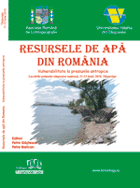11-13 June 2010. Water resources from Romania. Vulnerability to the pressure of man’s activities, Targoviste (Romania)

Resursele de apă din România. Vulnerabilitate la activităţile antropice
[Water resources from Romania. Vulnerability to the pressure of man’s activities]
Conference Proceedings
ISBN: 978-606-8042-65-7
11-13 June 2010, Targoviste - Romania
Editors
Petre Gâştescu
Petre Breţcan
RESURSELE DE APA DIN ROMÂNIA.
Potenţial, calitate, distribuţie teritorială, management
Petre GÂŞTESCU
Universitatea Hyperion, Bucureşti, Facultatea de Istorie-Geografie, Calea Călăraşilor, 169, Bucureşti,
e-mail gastescu_petre@yahoo.com
WATER RESOURCES FROM ROMANIA. Potential, quality, territorial distribution, management
Abstract. The water resources of Romania are quite modest, occupying the 21st place among the European states. According to the valuations, the inner rivers surface water resources represent around 42.1 billions c.m./year (without the Danube) from which, technically utilizable, 30 billions c.m./year, the ground waters represent 9 billions c.m./year (after other sources, they represent 11 billions c.m./year)from which, technically utilizable, 6.1 billions c.m./year. The natural lakes totalize around 2.3 billions c.m. Representing a local source. The marine waters pertaining to Romania represent an important resource as regards the biological fecundity. Their temporal and spatial distribution is unequally: the Carpathians with a surface of 27.9% of the territory of Romania generate 65.3% of the surface water resources; the most important volume of the rivers flow is registered during the spring (50%). As a result of such a status, it was necessary to prevalently build storage lakes which, in 2003, were counting 1449, what from the most important – 400 – were storing around 15 billions c.m. of water. The water requirements for the population, industry, agriculture, pisciculture supply have increased from 14.4 billions c.m./year in 1975 to 35 billions c.m./year in 1990 and to 46 billions c.m./year within the period 2000-2010. In order to assure a good knowledge and management of the water resources, in 1976, the National Programme for the Romanian Hydrographic Basins Management had been promoted, for the hydrographic basins and even for the territorial-administrative units (counties). In the framework of this programme, one had been achieved the building of stoarage lakes, damming in, water transfers between the hydrographic basins, irrigation systems extension, water quality monitoring. Many of these objectifs had been partially cut off after 1989, restarted under other terms and parameters as per the Water Framework Directive 2000/60, after Romania integration into European Union.
Keywords: rivers, lakes, ground waters, Black Sea
© Asociatia Romana de Limnogeografie (2008)

